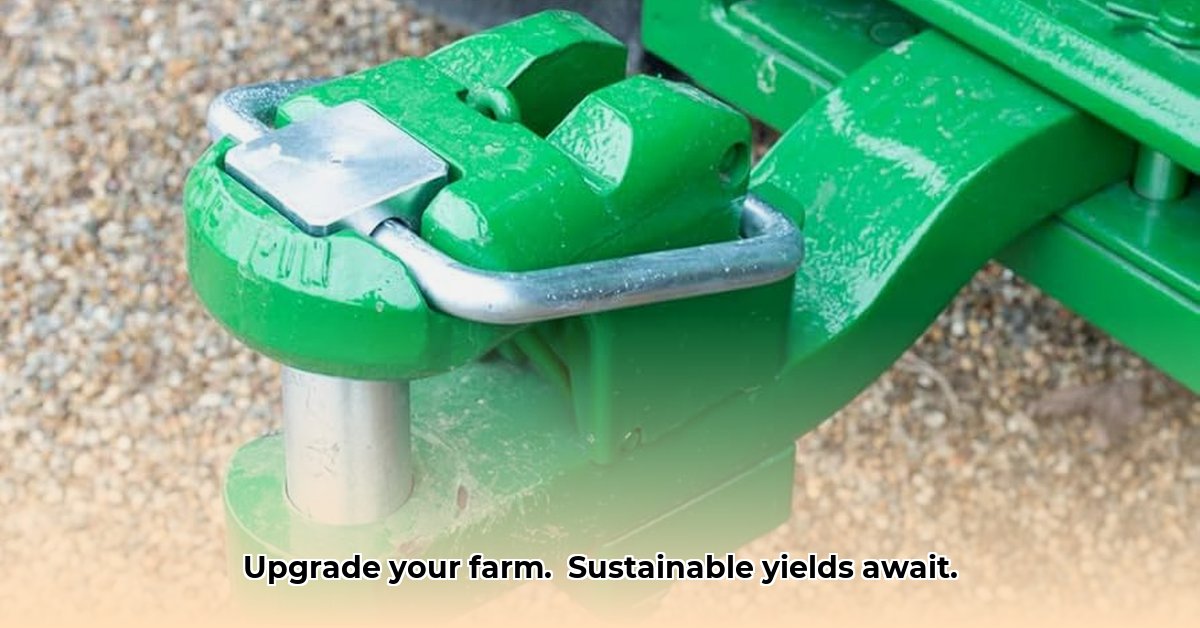
Choosing the Right Hitch Pins for Your Sustainable Farm
Selecting the appropriate heavy-duty tractor hitch pin is crucial for maintaining equipment functionality and preventing costly downtime. The wrong pin can lead to equipment damage, crop loss, and safety hazards. Let's break down the key factors to consider:
Weight Capacity: The pin's weight rating must exceed the combined weight of the implement and any attached equipment. Underestimating this can lead to catastrophic pin failure. Don't skimp on safety.
Terrain Considerations: Are you farming on relatively flat, even ground, or do you consistently encounter rough, rocky terrain? Rough terrain demands pins with higher tensile strength to withstand increased stress and vibration.
Pin Diameter and Hitch Compatibility: Precise matching between pin diameter and the tractor hitch receiver is non-negotiable. Improper fit can cause damage to both the pin and the tractor. Always double-check measurements before installation.
For more information on farm tractors, check out this helpful resource: Kubota tractors.
Pin Material and Construction: A Deep Dive
Heavy-duty hitch pins are predominantly constructed from hardened steel. However, the grade of steel significantly impacts the pin's durability and resistance to bending or shearing under stress. Higher-grade steel, indicated by a higher tensile strength rating (typically measured in pounds per square inch or MPa), translates to superior longevity and reduced risk of failure.
"Investing in high-quality pins is a smart long-term strategy," says Dr. Anya Sharma, Agricultural Engineering Professor at the University of California, Davis. "The cost savings from reduced downtime and equipment repair far outweigh the initial investment in superior pins."
Furthermore, consider pins with corrosion-resistant coatings, especially if you operate in humid or wet climates. These coatings significantly extend the pin's lifespan and reduce maintenance requirements.
Installing Hitch Pins Safely and Effectively: A Step-by-Step Guide
Improper installation is a major cause of hitch pin failures. Follow these detailed steps for a secure and safe installation:
Thorough Cleaning: Begin by meticulously cleaning both the hitch receiver on the tractor and the implement's attachment point. Remove all dirt, debris, and rust using a wire brush. This ensures a snug, secure fit and prevents premature wear.
Receiver Inspection: Carefully inspect the hitch receiver for any signs of damage, wear, or corrosion. Addressing any issues before installing the pin prevents potential problems.
Precise Pin Insertion: Gently guide the pin into the hitch receiver, ensuring proper alignment. Avoid forceful insertion, which can damage the pin or receiver.
Secure Fastening: Use a cotter pin or clevis pin to prevent accidental dislodgement of the hitch pin. This essential safety measure protects against serious accidents and equipment damage. Never operate with a loose pin.
Final Verification: Before operation, always double-check the secure connection between the implement and the tractor. This simple step prevents significant problems.
Routine Maintenance and Troubleshooting: Maximizing Pin Lifespan
Regular inspection is vital for early detection of potential issues. Inspect for:
Excessive Wear: Look for bending, cracking, or significant wear on the pin's surface.
Corrosion: Rust formation is an indicator of degradation.
Immediate Replacement: Any signs of damage mandate immediate pin replacement. Do not compromise safety.
Common Hitch Pin Issues and Solutions:
Bent Pins: Usually caused by excessive stress or impact. Replace immediately.
Sheared Pins: This often indicates improper installation or using an undersized pin. Carefully review the pin specifications and hitch receiver compatibility.
Broken Pins: This suggests severe wear or a material defect. Replace immediately and investigate the cause to prevent recurrence.
Using a quality lubricant (like high-temperature grease) periodically can reduce friction, extend pin life, and dampen noise.
Clevis Pins vs. Cotter Pins: Understanding the Differences
Two primary pin types exist for tractor hitches:
Clevis Pins: These offer quick implement changes due to their easy release mechanism. However, they require a corresponding clevis to maintain secure fastening.
Cotter Pins: These provide superior security but demand more time for installation and removal.
The best choice depends on your frequency of implement changes. Frequent switching favors clevis pins; safety-critical applications benefit from the added security of cotter pins.
The Importance of Investing in Quality: Long-Term Cost Savings
While cheaper pins might initially seem cost-effective, their shorter lifespan and increased failure rate negate any short-term savings. Investing in high-quality, heavy-duty pins ultimately reduces downtime, repair costs, and risk of accidents. This proactive approach to maintenance is a cornerstone of sustainable, efficient farming.
This comprehensive guide helps you confidently select, install, maintain, and troubleshoot heavy-duty tractor hitch pins. Remember, the proper functioning of these seemingly small components is critical for safe and productive farming operations.